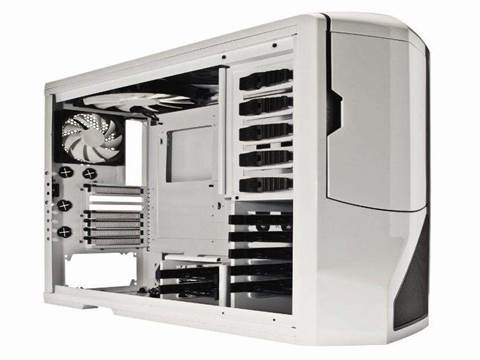Processor And Motherboard
We plugged the Core i7 980X into the LGA1366 socket on an Intel DX58SO motherboard. Core i7 processors support three separate memory channels, adding multi-channel modes of interleaved memory access to the traditional single-channel asynchronous mode.
Tri-channel and dual-channel modes access memory sequentially by spreading data across multiple memory channels. The result is reduced latency and improved performance, particularly for memory-intensive applications.
The 980X comes from the 32nm process, has a 12-MB cache (up from 8 MB in the 45nm Bloomfield) and can address as much as 16 GB non-ECC RAM. The chip is shipped with Intel's DBX-B cooling fan, which we put aside in favor of a liquid cooling solution from Corsair (covered later in the Memory and Cooling section).
No fewer than nine heat sinks adorn Intel's sturdy ATX-sized motherboard, cooling among other things the I/O controller hub, Marvell RAID logic and the X58 chip, which connects the processor through the QuickPath Interconnect to peripherals.
As is typical of Intel parts, all slots, ports and connectors on the DX58SO are clearly marked and documented on the board itself. There's also a quick reference sheet and a sticker intended for somewhere inside the PC's chassis and another for the outside rear panel. If you forget to connect your power supply to the auxiliary CPU power connector, the "CPU LED" will glow red to let you know.
The board's 12 USB 2.0 ports ought to satisfy most users, as will its six internal and two external SATA ports, plus digital audio, FireWire and Gbit Ethernet. There are four DIMM slots, three of which are colored to indicate correct positioning for three-channel memory, if desired. Improper memory placement won't cause damage, it simply forces the slightly slower asynchronous mode.
By far the most expensive part is the Intel Core i7 980X Extreme processor, which sells on the street for $US999. The DX58SO motherboard lists for $US219, but can cost slightly more on the street (Newegg has it for $US229).
NEXT: Graphics










.jpg&w=100&c=1&s=0)
_(8).jpg&w=100&c=1&s=0)







.jpg&q=95&h=298&w=480&c=1&s=1)


.jpg&q=95&h=298&w=480&c=1&s=1)


